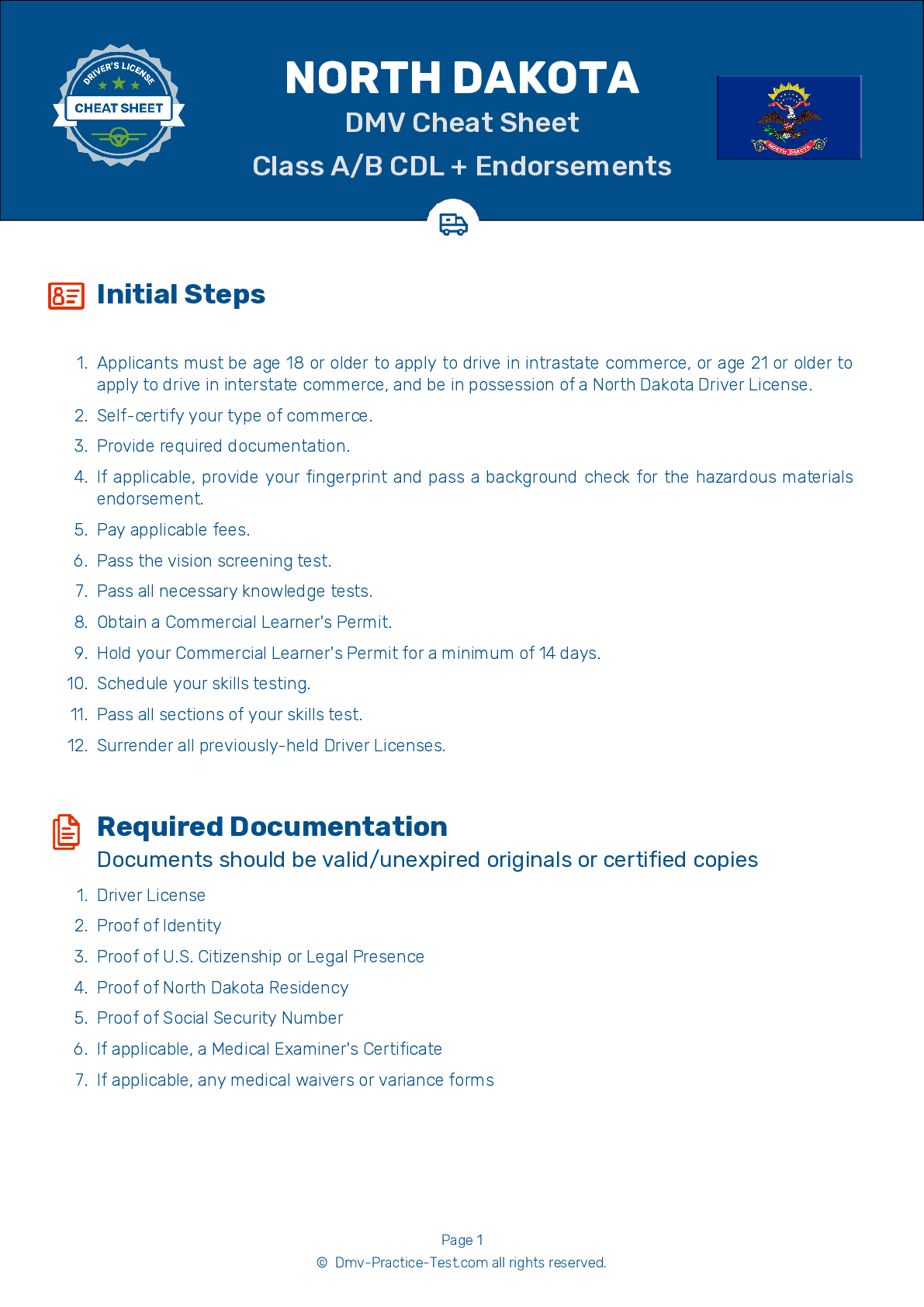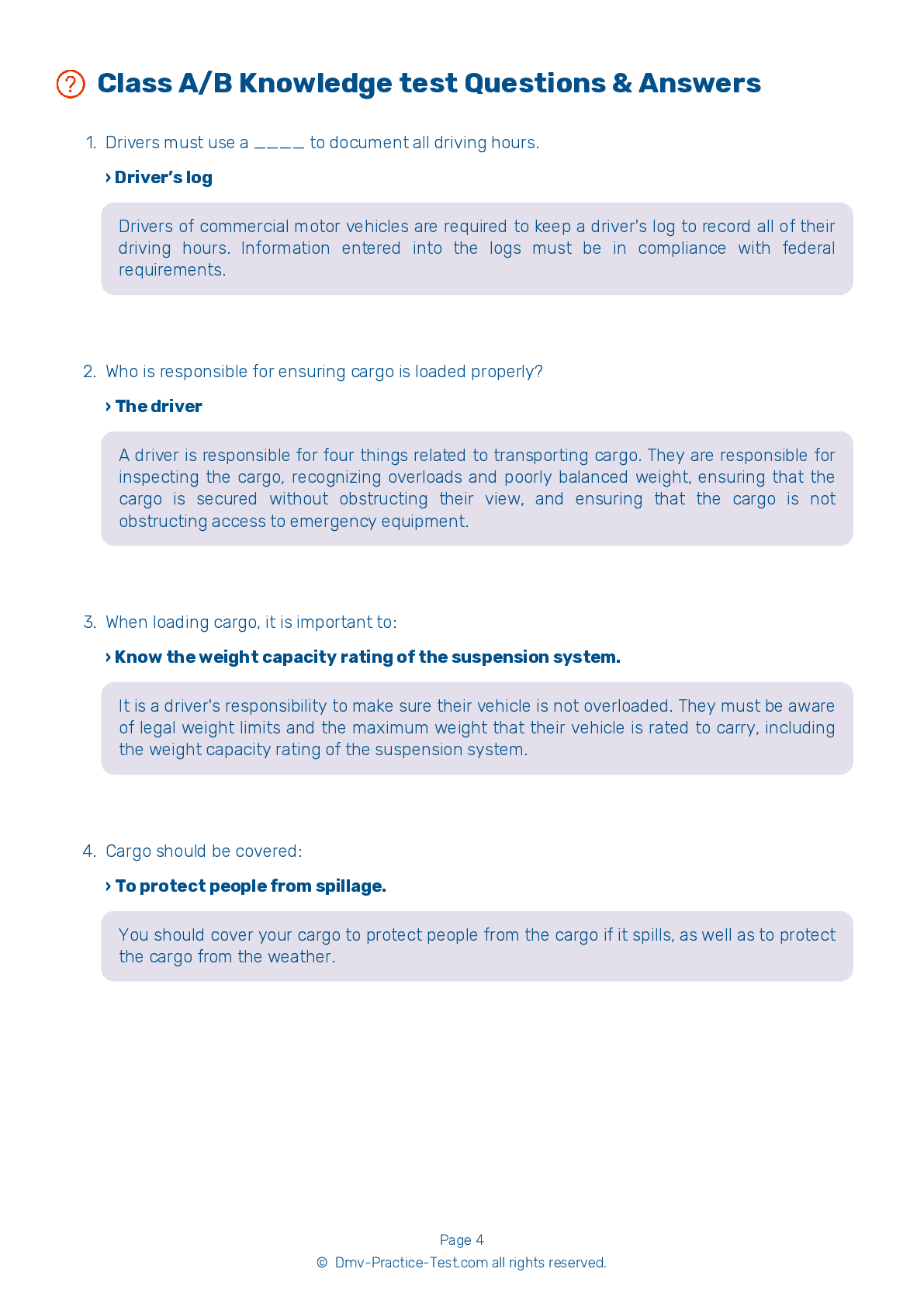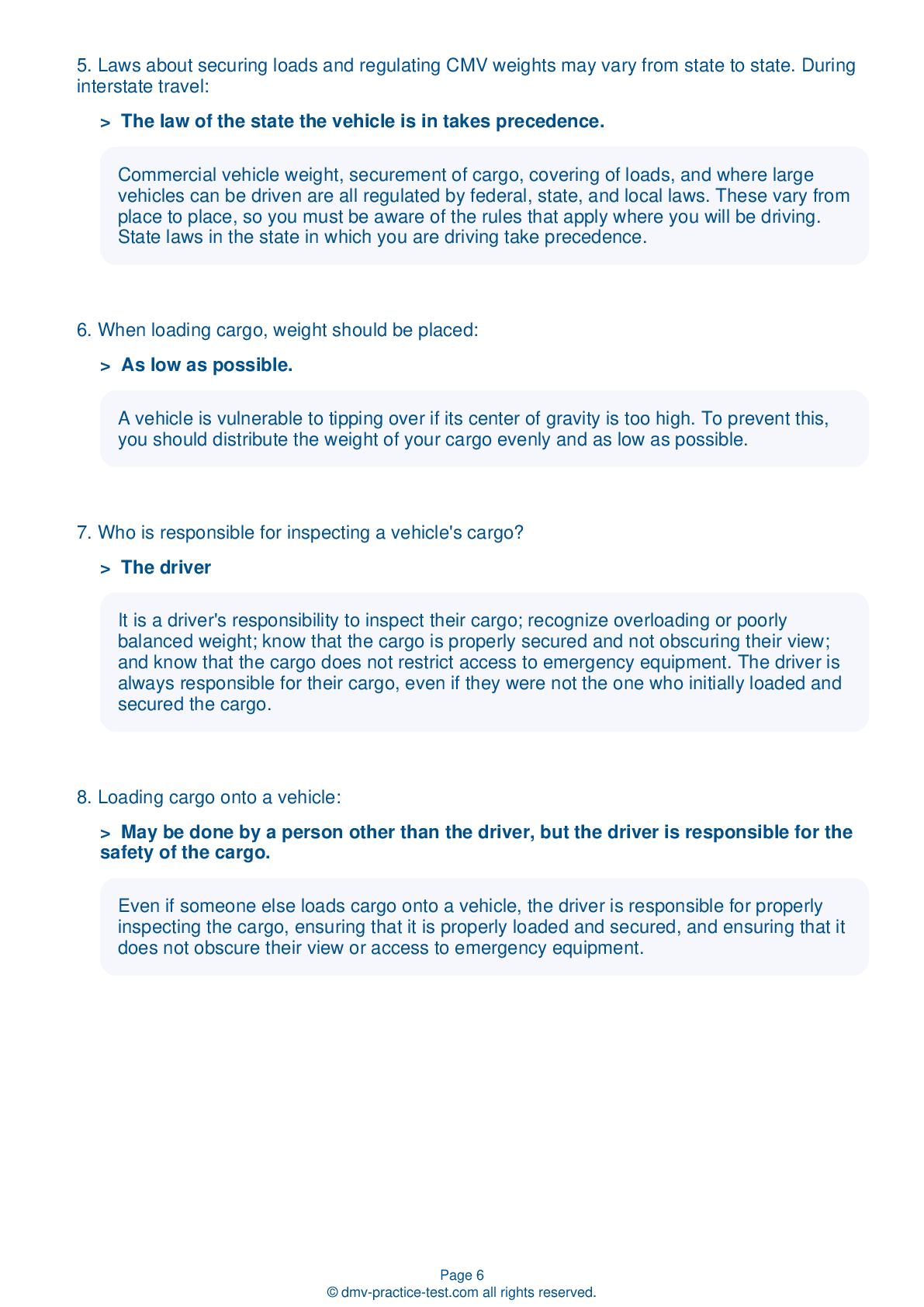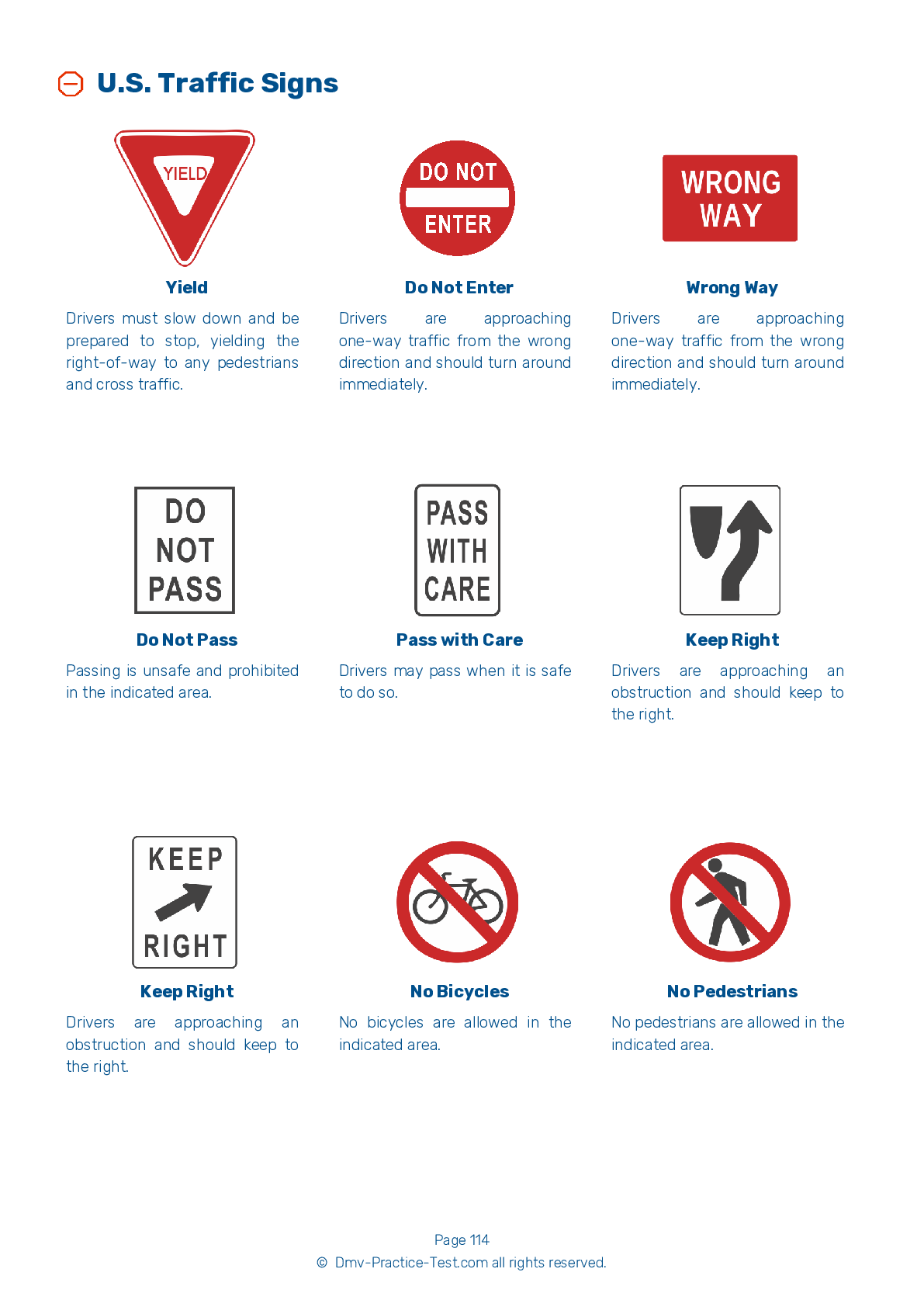Knowledge Test Class A #1
Class A Driving Test | North Dakota 2025 #1 Page 2 of 7
Train for FREE online with our North Dakota class A license test. The official exam test consists of several obligatory parts, with all of them checking your knowledge of different blocks of road rules. If you need to obtain a ND CDL class A permit in 2025, practice as much as possible. Free sample tests published on our website will help you check and improve your knowledge and boost your grades. Please bear in mind that CDL class A requirements may vary from state to state.
50
40
20
8 . During a vehicle inspection, ensure that lug nuts are all of the following, except:
Free of rust.
During a vehicle inspection test, you must ensure that all lug nuts are present, free of cracks and distortions, and showing no signs of looseness, such as rust trails or shiny threads. Verify that all bolt holes are free of cracks and distortions.
9 . What must be done if a load is over-length?
The emergency flashers must be activated.
Special equipment, such as warning flags or flashing lights, may be required if you are transporting an over-length load. When transporting such a a load, you will need to acquire the necessary permits. Driving is often limited to certain times.
10 . The steering wheel should be:
Cracked to allow for an improved grip.
To maintain proper control of your vehicle, the steering wheel should be held firmly with both hands. Your hands should be positioned on opposite sides of the wheel.
11 . When preparing to drive in the winter, be sure to check:
All of the above.
Before driving during the winter, make sure to check your defrosting and heating equipment, coolant and antifreeze levels, wipers and washers, tire tread, tire chains, lights, reflectors, and exhaust system. Clear ice and snow from all windows, mirrors, hand holds, steps, deck plates, and radiator shutters. Make sure the winterfront is not closed too tightly.
12 . How many daily hours of sleep does an adult need to maintain alertness?
Four to five
Being properly rested is essential to the safe operation of a CMV. To maintain alertness, most people need seven to eight hours of sleep per night.
13 . Dry bulk tanks:
Cannot be driven on interstates.
Dry bulk tanks require special care when being driven because they have high centers of gravity. Drivers should also be careful because the materials being carried can easily shift in transit, causing a change in the vehicle's handling.
14 . Tread depth in the major grooves on a front tire should be at least:
1/16 of an inch.
Tires need to have at least 4/32 of an inch of tread depth in every major groove on the front tires, and at least 2/32 of an inch of tread depth on other tires.
Search the best driving school in your neighbourhood
2025 North Dakota | Frequently Asked Questions
To secure a CDL Doubles/Triples endorsement in North Dakota, you must first hold a valid Commercial Driver's License (CDL). Then, you will need to pass the Doubles/Triples Knowledge test. The test covers topics like coupling and uncoupling, inspecting doubles and triples, and handling. After passing this test, the endorsement will be added to your CDL.
To obtain a CDL Doubles/Triples license, you first need a valid Commercial Driver's License (CDL). Then, you must pass the Doubles/Triples Knowledge Test. This test covers topics such as coupling and uncoupling, inspecting doubles and triples, and handling. After passing the test, the Doubles/Triples endorsement will be added to your CDL.
While North Dakota does not mandate specific training for a CDL Doubles/Triples endorsement, they do require passing the Doubles/Triples Knowledge Test. However, practical training can be beneficial for understanding coupling/uncoupling, inspecting, and handling doubles/triples. Some drivers opt for professional training programs to enhance their skills and increase their chances of passing the test.
Yes, in North Dakota, to obtain a CDL Doubles/Triples endorsement, you must pass the Doubles/Triples Knowledge Test. This written exam covers topics like coupling and uncoupling, inspecting doubles and triples, and handling. The endorsement is added to your CDL after you successfully pass this exam.
The CDL Doubles/Triples endorsement test in North Dakota is a knowledge test, not a skills test. It focuses on understanding specific rules and procedures related to operating such vehicles. Topics include coupling and uncoupling, inspecting doubles and triples, and crucial handling differences. Practical skills or maneuvers are not demonstrated during this written test.
No, it's not permissible. In North Dakota, like in all other states, you must have a valid CDL Doubles/Triples endorsement to legally operate double or triple trailers. Driving without the appropriate CDL endorsement is a violation and could result in fines, penalties, and potential disqualification from driving commercial vehicles.
You can append the CDL Doubles/Triples endorsement to your current commercial driver's license in North Dakota. You don't need to initiate a new application for a CDL. However, you must pass the Doubles/Triples Knowledge Test to get the endorsement. Once you pass, the endorsement is added to your existing CDL.
Yes, there are constraints. Drivers with a CDL Doubles/Triples endorsement in North Dakota must only operate vehicles that their license classifies. For instance, a Class B CDL holder can't operate a Class A vehicle. Additionally, all federal and state regulations regarding hours of service, vehicle maintenance, and safety must be strictly adhered to.
In North Dakota, double trailers can't exceed 81 feet in overall length. For weight, the maximum gross vehicle weight (GVW) is 105,500 lbs. However, specific weight depends on the vehicle's axle configuration. Triple trailers are not generally permitted unless on specific routes or for emergency relief efforts. Always check with the Department of Transportation for up-to-date regulations.
Yes, drivers with a CDL Doubles/Triples endorsement must follow specific safety guidelines. These include conducting pre-trip safety inspections, ensuring the correct coupling and uncoupling of trailers, and managing the high rollover risk associated with these vehicles. Drivers must also be aware of the increased stopping distance required for double/triple trailers and adjust their driving accordingly.




